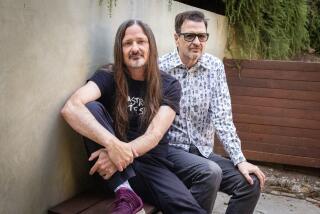Here They Come
- Share via
Even in a year that saw original lineup reunions of KISS and the Sex Pistols, the truly startling news is that Micky, Michael, Davy and Peter are back together. Thirty years after their prefabricated band got its start, here they come, with a new album of pop tunes: Hey, hey, it’s the Monkees.
As network-bred, record-label-controlled pop idols, the Monkees blurred the line between fact and fiction and managed for a period in the mid-’60s to top both the Nielsen ratings and the Billboard charts.
Micky Dolenz, Michael Nesmith, Davy Jones and Peter Tork were cast as members of the band for NBC’s “The Monkees” TV show in 1965 and supplied only vocals to such early hits as “Last Train to Clarksville” and “I’m a Believer.” By 1967, the TV group had become a bona fide band, and its later records contained a good deal of music written and performed by actual Monkees.
The band even toured as a self-contained foursome through ’67 and ’68 and, in one of rock’s oddest footnotes, gave Jimi Hendrix his first big break in the United States as its opening act.
But the new record, “Justus,” released last week by Rhino Records, is the first-ever Monkees album to be entirely Monkee-written, Monkee-performed and Monkee-produced.
“It’s a little odd,” says Nesmith, gathered with his refabricated bandmates at his Santa Monica office. “We listened to this music and looked at each other and said, ‘This sounds like a Monkees record. How can that be? We didn’t write the early Monkees records.’ ”
The four--slightly thicker in the waist and sporting slightly less hair--don’t seem to have lost any of the Monkees’ esprit de corps. The group was always as much a comedy troupe as a pop act--John Lennon once said the Monkees deserved comparison with the Marx Brothers rather than with the Beatles. And today, one Monkee can hardly finish a sentence without being swarmed with quips and shtick from the others.
Though Tork, Dolenz and Jones have toured as the Monkees in recent years, Nesmith was never enthusiastic about reuniting as an oldies act. He has pursued a successful career as a solo artist, and as a producer of films and videos, and at times has sought to distance himself from his days as a Monkee.
So when the group is asked what brought them back together as a foursome, the answer is surprising.
“It was Mike’s idea,” Tork says.
“Well,” Nesmith says with a shrug, “We’ve talked about it for a long time, and suddenly we were all in L.A. at the same time. So I called the guys up and said let’s jam. And jam we did.”
“Mike called Micky and I,” continues Tork. “And we got together for no other reason than to see each other and play loudly. We played ‘Clarksville’ and ‘Steppin’ Stone’ right away. We worked up ‘Pleasant Valley Sunday.’ It was surprising that it was no surprise. It all came back. We brought in Davy, and we worked on some new stuff, and then we realized, ‘Good Lord, we’re ready to make a record.’ ”
The members say they were undaunted at the prospect of making the first Monkees record on which they controlled every note and every lyric.
“We never really discussed it,” says Dolenz, shrugging. “But the understanding came around that it was just going to be us. It kind of fell together. We’d done some writing and playing and producing before, so that wasn’t a challenge. It was more of a. . . .”
“A threat,” chimes in Jones.
“Justus” includes one pumped-up version of an older Monkees tune, Nesmith’s “Circle Sky,” but is otherwise a fresh-sounding collection of solid, well-crafted new tunes that capture Monkees charm without sounding like the old hits.
Nesmith said he didn’t have any feeling of competing with the band’s pop legacy.
“I liked the idea that we just didn’t have anything to prove to anybody but ourselves,” he says. “We weren’t under any pressure at all. It was just, ‘We want to do this--we’re going to do it.’ ”
As for playing as a band, Nesmith says the Monkees’ current sound was forged in those early concerts.
“When the TV show was a hit, they told us to play concerts,” he explains. “So we went out and just the four of us did two years of concerts around the world. I think of those times fondly, but sometimes I can’t believe we were out there. ‘Oh--we’re a band? OK, here we go.’ ”
“We ended up being a pretty good garage band,” says Dolenz, laughing. “It’s just that the garage happened to be RCA Victor studios.”
All four Monkees seem prepared to keep the band around a while longer--with concert dates in Europe confirmed for early next year. U.S. appearances are being discussed, and there’s even some talk of a feature film (which would be their second--the group wrote and starred in 1968’s “Head”).
Nesmith says that as far as he’s concerned, the group’s new music-making isn’t just monkeying around.
“The idea that we were going to get in a place where we’d be left alone to create between the four of us was sobering,” he says. “This isn’t just goofball stuff. The Monkee phenomenon fascinates me, and I love being a part of it and having been a part of it. Oddly enough, I happen to take the Monkees more seriously than a lot of other stuff in my life.”
More to Read
The biggest entertainment stories
Get our big stories about Hollywood, film, television, music, arts, culture and more right in your inbox as soon as they publish.
You may occasionally receive promotional content from the Los Angeles Times.










